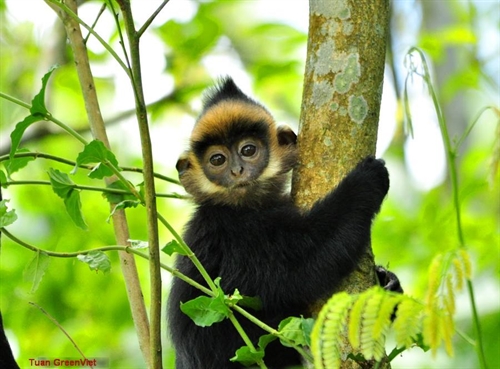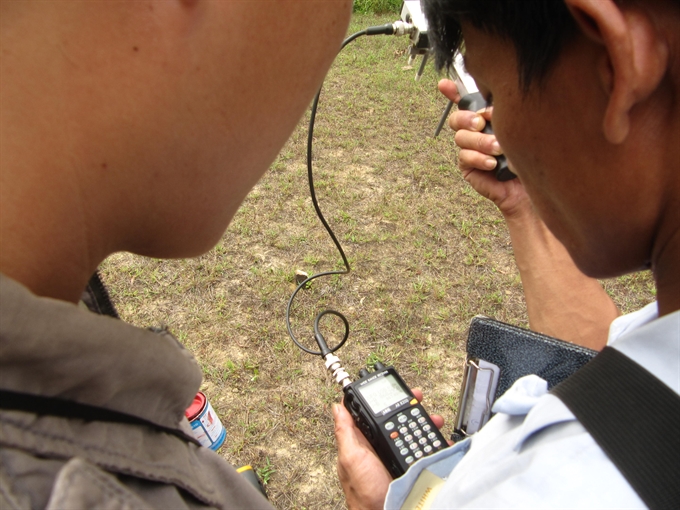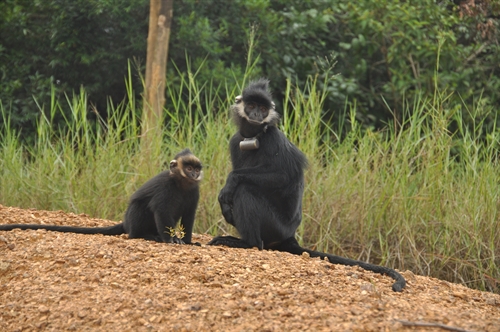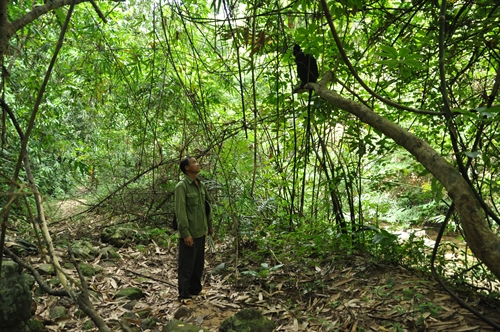 Sunday/Weekend
Sunday/Weekend

Biologists, rangers and researchers are all working together on a reintroduction programme for Hatinh langurs run by the Endangered Primates Rescue Centre (EPRC) in Ninh Bình Province. The langurs, who have been bred in captivity, are gently released into the wild, with rangers tracking them daily to see how they integrate into the wild for the first time in their lives. Hoai Nam reports.
 |
| Langur freedom: Hatinh langurs (Trachypithecus hatinhensis) are released into Kẻ Gỗ Nature Reserve in central Hà Tĩnh Province during a reintroduction programme for Hatinh langurs by the Endangered Primates Rescue Centre (EPRC). Photo Tuan GreenViet |
Biologists, rangers and researchers are all working together on a reintroduction programme for Hatinh langurs run by the Endangered Primates Rescue Centre (EPRC) in Ninh Bình Province. The langurs, who have been bred in captivity, are gently released into the wild, with rangers tracking them daily to see how they integrate into the wild for the first time in their lives. Hoai Nam reports.
Biological researcher Trần Ngọc Toàn woke up when a signal rang out from his Global Positioning System (GPS).
It was around 9am, a day after three Hatinh langurs (stripe-headed black langurs, found in the central province of Hà Tĩnh, scientifically called Trachypithecus hatinhensis) were released into the Kẻ Gỗ Nature Reserve in the central province of Hà Tĩnh. The release was part of a reintroduction programme for Hatinh langurs run by the Endangered Primates Rescue Centre (EPRC) in Ninh Bình.
The detection device helped Toàn get closer to where the three langurs – one male and two females – were seeking food in their new habitat.
He found them in high trees a few hundred metres from where they were released in the forest. They had started moving to find leaves and fruit to eat in the morning – their favourite time for filling up their stomachs before it gets hot at noon.
It’s the second time that first generation Hatinh langurs, which are captive-born individuals from the EPRC in Cúc Phương National Park, have been returned to nature with the aim of increasing the population of the endangered species in the forest.
 |
| Chasing langurs: Biologists, rangers and researchers track Hatinh langurs in Kẻ Gỗ Nature Reserve in Hà Tĩnh Province after the captive-born primates are released into nature. VNS Photos Công Thành |
Last year, five captive-born Hatinh langurs were released in Kẻ Gỗ Nature Reserve, but two of them died, one went missing and the remaining two returned to the EPRC.
“It’s a hard job for us when we have to track and supervise them twice a day in the first year. They were born and grew up in captivity in the EPRC, so it’s the first time they have actually returned to start a new life in the wild,” Toàn said.
“They have to begin their wild instinctual lifestyle and get familiar with the new forest. They have to seek food, have sex and reproduce to build up a new flock of langurs,” he said.
Toàn and his colleagues Hoàng Quốc Huy and Bùi Văn Tuấn from the Biodiversity Conservation Centre (GreenViet), an NGO in biodiversity communications in Việt Nam, work in shifts to observe the action of the langurs in their new habitat, making sure that they live well after being released.
“We have assigned a safe area of the forest where food is available for the langurs before they move further into the 45,000ha Kẻ Gỗ Nature Reserve. Leaves and fruit are the main foods of the Hatinh langurs, so they should survive for the first year,” said Tuấn.
“All the released langurs were equipped with tracking devices for the one-year supervision period, after which they will live by themselves in the wild as their ancestors did,” Tuấn said.
 |
| Breaking free: Hatinh langurs start a new life in nature in Kẻ Gỗ Nature reserve after a long time growing up in captivity. |
After a lunch break, Toàn returned to see how the langurs were doing. He was surprised to find that only the male and one female remained, while the other female had moved on.
Toàn speculated that a war of love had occurred between the two females, and the smaller one had had to move away from the lone male langur.
“I guess that the bigger female won the war in the fight for the love of the male langur now they are ready to reproduce,” Toàn said, adding that the strongest female often leads a flock.
Having completed a two-hour tracking and observation with the newly released langurs, Toàn finally found that the male langur had moved to the highest tree to howl for hours for the missing female.
Tuấn said they had started living in a new flock and the male needed more than one female for mating.
One month later, Huy reported that the three langurs had joined with a group to live peacefully in the forest.
Huy hoped the langurs would have more sex in season when spring food was plentiful and new offspring could flourish.
Trần Hữu Vỷ, director of GreenViet, described the second release of captive born Hatinh langurs.
“The previous time we released them in the forest near a flock of monkeys, and the appearance of a new species in the forest sparked a war between them. The monkeys started attacking the newly released langurs, killing two of them,” Vỹ recalled.
Vỹ said a small langur without a tracking device was driven away by the monkeys and went missing in the deep forest.
He said local residents living around the forest recently found traces of the missing langur in the forest.
Vỷ said the wildlife reintroduction programme is a challenging endeavour for biologists in Việt Nam as it was difficult to keep captive born primates alive in the wild.
“They get familiar to the support from caretakers with food, medicine and protection, so they often find it hard to return to nature where their ancestors lived,” Vỹ said.
“They have to relearn their basic wild instincts of seeking food, regrouping and getting herbs to prevent diseases. Serious pollution, illegal logging, hunting and the expansion of farms into the forest have threatened many wild species and primates with extinction,” Vỹ warned.
He said the release of captive born species and primates would trigger the revival of endangered species and increase the biodiversity of the forest.
Reintroduction
The Hatinh langurs, which are listed as endangered species by the International Union of Conservation of Nature (on the IUCN Red List of Threatened Species), exist only in a restricted area of central Việt Nam and eastern Laos.
The largest population of 200 individuals can be found in Quảng Bình, and a small population lives in Quảng Trị.
Tilo Nadler, director of the Endangered Primate Rescue Centre in Cúc Phương National Park, said the initial discovery and scientific description of Hatinh langurs was not actually done in Hà Tĩnh, but in Quảng Bình.
“We started the first reintroduction programme for Hatinh langurs as a pilot project in Phong Nha-Kẻ Bàng National Park six years ago. We have released eight captive-born individuals from the EPRC into a very large, electric fenced semi-wild area,” Nadler said.
“The animals have produced a number of offspring and the population has now increased to 24 or 25 individuals.”
He said an important conservation effort for rare and endangered species should be the establishment of at least a second viable population.
He explained that a single population can be at risk from a number of impacts – natural disasters, diseases and high local hunting pressures, so he chose Kẻ Gỗ Nature Reserve as a place for the establishment of a second population, as the forest in the reserve is in good condition.
“The first release of five langurs in the reserve last year ended unfortunately with a completely unexpected disaster. But the release of animals, especially captive born ones, is always risky and often ends in failure.
“With this new attempt we hope to have a good start, and the captive population at the EPRC can provide a sufficient source of individuals to continue the project if it shows success this time,” Nadler said.
He said about 80 Hatinh langurs have been born at the EPRC, not all grown up as yet, but this stock could provide individuals for the establishment of a viable wild population.
Nguyễn Quang Châu, deputy director of Kẻ Gỗ Nature Reserve, said the forest is an appropriate habitat for the mass development of Hatinh langurs.
“The reserve is surrounded by 28,000ha of Kẻ Gỗ reservoir and the approach of local residents is limited. We also have co-operation with local residents living in eight communes within the buffer zone to protection of the flora and fauna in the reserve,” Châu said.
“The reserve with a capacity of 345 million cubic metres of water, and is abundant with aquatic species, but it also provides water for over 18,000ha of rice farms in the three districts of Thạch Hà, Cẩm Xuyên and Hương Khê,” Châu said.
Châu said the reserve management allows local people to fish in the reservoir to supplement their diet, and they act as informers of illegal logging and hunting in the forest.
He said that fishing in the reservoir was a breadwinner for the 50,000 population in the reserve’s buffer zone. VNS
The 45,000ha reserve is home to 78 animal species, of which 12 are listed in the Red Book of Việt Nam including the Vietnamese or Edward’s pheasant (Lophura hatinhensis), a critically endangered species; the imperial pheasant (Lophura imperialis), the yellow-cheeked gibbon (Hylobates gabriellae) and the giant muntjac (Muntiacus vuquangensis).
Also found in the reserve are 298 bird species and 567 flora species. The reserve, which is 17km away from Hà Tĩnh City, could be developed as an eco-tourism site and as a destination for biological researchers.
 |
| Observing: A ranger gets closer to a newly released Hatinh langur in the forest of Kẻ Gỗ Nature reserve in Hà Tĩnh Province. |




